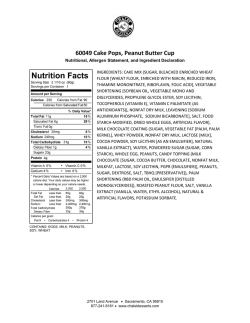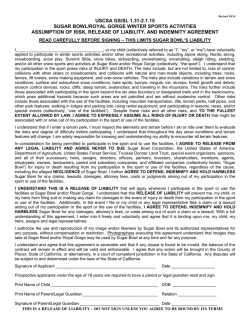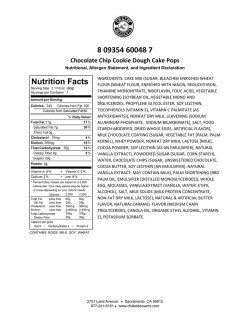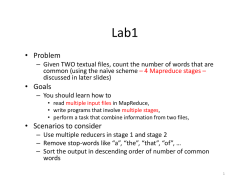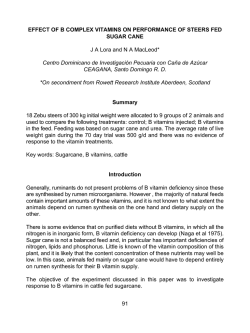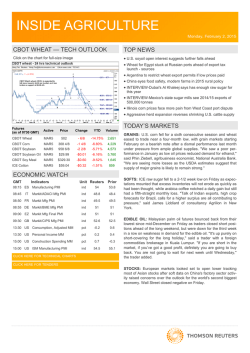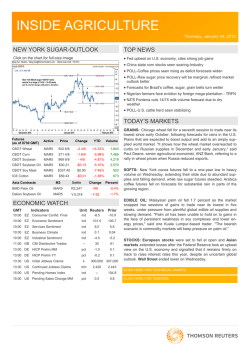
METEORITIC SUGAR DERIVATIVES: ENANTIOMER EXCESSES
46th Lunar and Planetary Science Conference (2015) 2993.pdf METEORITIC SUGAR DERIVATIVES: ENANTIOMER EXCESSES AND LABORATORY ATTEMPTS AT DUPLICATION. 1G. Cooper and 2A. C. Rios 1Exobiology Branch, NASA-Ames Research Center, MS 239-4, Moffett Field, CA 94035, [email protected], 2NASA Postdoctoral Program, Exobiology Branch, NASAAmes Research Center, MS 239-4, Moffett Field, CA 94035, [email protected] Introduction: Carbonaceous chondrites contain several classes of organic compounds of interest in the study of pre-biotic chemistry and the chemistry of the origin of life. Identified compounds include carboxylic acids, amino acids, amides, and sugar derivatives [1-3]. Many of these compounds are chiral, which means that they are composed of two non-superimposable mirror images (i.e., "enantiomers"). Such molecules are important on Earth because biological polymers (e.g., proteins and nucleic acids) are homochiral: their monomers consist of only one of the two enantiomers. In contrast, naturally occurring non-biological synthetic processes that take place today or previously in the early solar system, are generally assumed to produce racemic mixtures, which are equal amounts of enantiomers. Common abiotic synthesis refers to the absence of asymmetric influences or starting material in natural syntheses, and 50:50 ratios (racemic) of D and L enantiomers are the norm with the majority of individual meteoritic compounds [3, 4]. However, as originally shown by Cronin and Pizzarello [5], some of the more unusual amino acids contained slightly more of one enantiomer (the L form). These excesses have been confirmed by 13C and D isotopic analyses that also point to cold interstellar origins for the formation of precursor compounds. The origins of the enantiomer enrichments are still subject to debate, however the findings may have implications for the origins of homochirality on Earth. Previously, we identified several chiral sugar derivatives in carbonaceous meteorites and a preliminary analysis revealed anomalous D enrichments in some of the sugar acids [6]. This presentation will focus on updated molecular and enantiomer analyses of meteoritic sugar derivatives and include sugar alcohols. It will also include the results of attempts at laboratory re-creation of such excesses. In the case of the origin(s) of enantiomer excesses in meteoritic amino acids, plausible mechanisms include the preferential destruction of one enantiomer of a given compound by circularly polarized UV light [7] or the synthesis of slightly more of one enantiomer under simulated interstellar conditions [8, 9]. Mechanisms utilizing magneto-chiral effects have been shown to produce small (~ 10-4) enantiomer excesses in a (pre-made) metalorganic compound [10]. If the forces that acted on organic compounds (and/or their precursors) in the early solar system are common, then specific laboratory experiments may indicate whether enantiomer excesses in organic compounds are available for the origin of life in a multitude of planetary systems. Analytical techniques: The standard and meteoritic compounds analyzed include all straight-chained, sugar alcohols and sugar acids up to six carbons and all straight-chained aldehyde sugars (aldoses) up to six carbons, i.e., glyceralde-hyde to glucose, allose, etc. Where needed, D and/or L sugar acid enantiomers were prepared by bromine oxidation of the corresponding sugar. The majority of analyses are done by derivatization and gas chromatography-mass spectrometry (GC-MS). Carboxylic groups were derivatized to their isopropyl ester/O-triflouroacetyl (ISP-TFA), ethyl ester/O-triflouroacetyl (Et-TFA), or isopropyl ester/Opentafluoropropionic (ISP-PFA) derivatives. An Agilent The GC-MS consisted of an Agilent 6890 GC interfaced to a model 5975 quadrupole mass spectrometer. In many applications the GC was fitted with a Varian (Chrompack) Chirasil Dex-CB column (25m x 0.25) for separations. Typical GC injector temperatures are near 200OC and the helium flow rate varies between 1-1.7 ml/min. Typical MS detector conditions: injector - 200O C; quadrupole MS temp.,150O; carrier gas, helium; transfer line, 200O C; electron voltage, 70ev. Typical GC conditions: initial oven temp., 45O C; heat at 3O C/min to 700 C, hold for 30 min - heat at 3O C/min. to 200O C. Results of 5-carbon sugar acid enantiomer analysis: Figure 1 shows one enantiomer analysis of the five-carbon sugar monoacids from the Murchison meteorite. Ribonic, xylonic, and lyxonic acids showlarge D excesses. Arabinonic acid also has a large D excess but must be anlyzed on a diffrent GC column for D/L separation. It is significant that all four of the possible straight-chained five-carbon sugar acids are present, including the rare lyxonic acid, and their abundances are in equilibrium proportions [11]. Lyxonic acid is the corresponding acid of the sugar lyxose, which is rare in biological systems, again inferring that a significant portion of these compounds is indigenous to the meteorites. As shown previously [6] glyceric acid is racemic but threonic acid (4-carbons) also possesses a relatively large D excess. Preliminary analysis 46th Lunar and Planetary Science Conference (2015) of the sugar alcohols also also indicate possible excesses. References: [1] Botta O. and Bada J. L. (2002) Surveys in Geophysics 23, 411-465. [2] Sephton M. A. (2002) Nat. Prod. Rep. 19, 292-311. [3] Pizzarello S., Cooper G. W., Flynn G. J. (2006) In "meteorites and the early Solar System II". D. Lauretta, L. A. Leshin, and H. Y. McSween Jr., Eds. University of Arizona Press. [4] Aponte J. C., et al. (2014) Geochim. Cosmochim. Acta 131, 1–12. [5] Cronin J. R. and Pizzarello S. (1997) Science 275, 951-955. [6] Cooper G., Sant M., Asiyo C. (2009) Lunar Planet. Sci. Conf. Abs # 2537. [7] Flores J., Bonner W. A., Massey G. A. (1977) JAChS 99, 3622-3625. [8] de Marcellus P, et al. (2011) ApJL 727, L27. [9] Modica et al. (2014) ApJ 788, 79-90. [10] Rikken G. and Raupach E. (2000) Nature 405, 932-935. [11] Kalman M., et al. (1987) J. Carbohydr. Chem. 6, 587-592. Figure 1. Enantiomer analysis of 5-carbon sugar acids from the Murchison meteorite. 2993.pdf
© Copyright 2024
